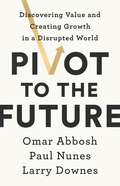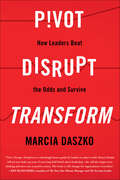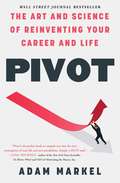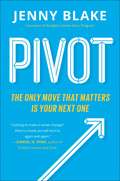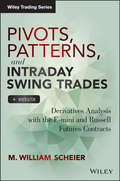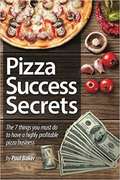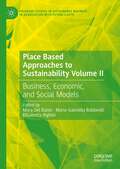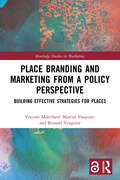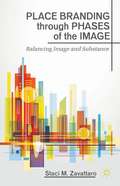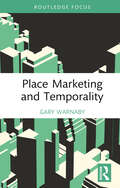- Table View
- List View
Pivot to the Future: Discovering Value and Creating Growth in a Disrupted World
by Larry Downes Paul Nunes Omar AbboshThe proven, effective strategy for reinventing your business in the age of ever-present disruptionDisruption by digital technologies? That's not a new story. But what is new is the "wise pivot," a replicable strategy for harnessing disruption to survive, grow, and be relevant to the future. It's a strategy for perpetual reinvention across the old, now, and new elements of any business.Rapid recent advances in technology are forcing leaders in every business to rethink long-held beliefs about how to adapt to emerging technologies and new markets. What has become abundantly clear: in the digital age, conventional wisdom about business transformation no longer works, if it ever did.Based on Accenture's own experience of reinventing itself in the face of disruption, the company's real world client work, and a rigorous two-year study of thousands of businesses across 30 industries, Pivot to the Future reveals methodical and bold moves for finding and releasing new sources of trapped value-unlocked by bridging the gap between what is technologically possible and how technologies are being used. The freed value enables companies to simultaneously reinvent their legacy, and current and new businesses.Pivot to the Future is for leaders who seek to turn the existential threats of today and tomorrow into sustainable growth, with the courage to understand that a wise pivot strategy is not a one-time event, but a commitment to a future of perpetual reinvention, where one pivot is followed by the next and the next.
Pivot to the Future: Discovering Value and Creating Growth in a Disrupted World
by Larry Downes Paul Nunes Omar AbboshDisruption by digital technologies? That's not a new story. But what is new is the "wise pivot," a replicable strategy for harnessing disruption to survive, grow, and be relevant to the future. It's a strategy for perpetual reinvention across the old, now, and new elements of any business.Rapid recent advances in technology are forcing leaders in every business to rethink long-held beliefs about how to adapt to emerging technologies and new markets. What has become abundantly clear: in the digital age, conventional wisdom about business transformation no longer works, if it ever did.Based on Accenture's own experience of reinventing itself in the face of disruption, the company's real world client work, and a rigorous two-year study of thousands of businesses across 30 industries, Pivot to the Future reveals methodical and bold moves for finding and releasing new sources of trapped value-unlocked by bridging the gap between what is technologically possible and how technologies are being used. The freed value enables companies to simultaneously reinvent their legacy, and current and new businesses.Pivot to the Future is for leaders who seek to turn the existential threats of today and tomorrow into sustainable growth, with the courage to understand that a wise pivot strategy is not a one-time event, but a commitment to a future of perpetual reinvention, where one pivot is followed by the next and the next.
Pivot, Disrupt, Transform: How Leaders Beat the Odds and Survive
by Marcia DaszkoWhen the status quo no longer works, the contrarian perspective reigns! In this innovative business how-to, leadership expert Marcia Daszko draws on her expertise to guide leaders at any level through a three-step process to radically improve their businesses: first, recognize and stop outmoded ways of thinking that fail to move the business forward (like focusing on the bottom line, conducting performance appraisals, and searching for best practices); second, start taking steps to introduce new, innovative ways of thinking and contrarian practices (such as developing leaders with the capacity to effect change, creating an interconnected team, and seeking knowledge through questions); and finally, transform your company into a more resilient, adaptive, and united organization. Recent studies have reported that 90% of start-ups will fail. In Silicon Valley alone, this means that more than 5,400 of the current 6,000 startups will flounder and disappear. But risky and cash-strapped start-ups are not the only corporate fatalities: More than 60% of the original Fortune 500 corporations no longer exist. Given these statistics, how can organizational leaders and their employees beat the odds and survive? The only solution is to question the usual business practices, re-think how to lead and inspire, challenge the accepted beliefs, and toss out the failures to accelerate business growth and profitability. Using Marcia's three-part stop, start, transform method, readers will learn to pursue significant untapped opportunities, achieve their organization's competitive edge, and pivot, disrupt, and adapt to unexpected levels of success.
Pivot: The Art and Science of Reinventing Your Career and Life
by Adam MarkelPublic speaker, transformative teacher, and CEO of Peak Potentials, Adam Markel has been inspiring people to find their best work for years. Now, for the first time, he presents his practical program for people who are looking to reinvent themselves. Here’s how to “get in touch with your real self, decide exactly who you are and what you want, and make your life into a masterpiece,” raves Brian Tracy, author of The Power of Self-Confidence.Whether you are out of work or want to change where you are now, Pivot inspires you on a cellular level to make lasting life changes possible. This seminal guide to successfully changing your life for the better provides stories, prompts, clear step-by-step exercises, and calls to actions throughout. You’ll follow the steps of career reinvention: Creating a Vision, Getting Clear, Having a Definite Plan, Thinking Boldly, Relentless Focus, Support, and Spiritual Practice. By changing self-limiting beliefs—the internal pivot to finding clarity about what you want—you can effectively deal with the mental and emotional obstacles that normally stop you from reaching your career goals. Based on his own personal story and the success of thousands of students, Markel provides a clear and applicable program perfect for “taking charge of your life and realizing your potential” (Sharon Lechter, author of Think and Grow Rich for Women).
Pivot: The Only Move That Matters Is Your Next One
by Jenny Blake<p>Jenny Blake, author of <i>Life After College</i> and former career development program manager at Google, reveals how to methodically make your next career move by doubling down on what is already working. <p>Careers are not linear, predictable ladders any longer; they are fluid trajectories. No matter our age, life stage, bank account balance, or seniority, we are all being asked to navigate career changes much more frequently than in years past. The average employee tenure in America is just four to five years, and even those roles change dramatically within that time. Our economy now demands that we create businesses and careers based on creativity, growth, and impact. In this dynamic world of work, the only move that matters is your next one. <p>Drawing from her own experience and those of other successful pivoters, Jenny Blake has created a four-stage process that teaches anyone how to seamlessly and continually: <p> <li>Double-down on existing strengths, interests, and experiences <li>Find new opportunities and identify skills to develop without falling prey to analysis-paralysis and compare-and-despair <li>Run small experiments to determine next steps <li>Take smart risks to launch with confidence in a new direction </li> <p> <p>This book is for anyone searching for an answer to the question, "What's next?" <p>Whether you have hit a plateau in your perfect-on-paper job, are considering taking on a new role in your current job, are thinking about starting your own business, or you want to move into a new industry altogether, one thing remains clear: your career success depends on your ability to determine your next best move. <p>If change is the only constant, let's get better at it.</p>
Pivotal Decade: How the United States Traded Factories for Finance in the Seventies
by Judith SteinIn this fascinating new history, Judith Stein argues that in order to understand our current economic crisis we need to look back to the 1970s and the end of the age of the factory--the era of postwar liberalism, created by the New Deal, whose practices, high wages, and regulated capital produced both robust economic growth and greater income equality. When high oil prices and economic competition from Japan and Germany battered the American economy, new policies--both international and domestic--became necessary. But war was waged against inflation, rather than against unemployment, and the government promoted a balanced budget instead of growth. This, says Stein, marked the beginning of the age of finance and subsequent deregulation, free trade, low taxation, and weak unions that has fostered inequality and now the worst recession in sixty years. Drawing on extensive archival research and covering the economic, intellectual, political, and labor history of the decade, Stein provides a wealth of information on the 1970s. She also shows that to restore prosperity today, America needs a new model: more factories and fewer financial houses.
Pivotal Ventures: Bending the Curve on Women's Power and Influence
by Lynda M. Applegate Ankita PandaCase
Pivoting
by Jacqueline Binkert Ann L. ClancyChange is a necessary, though sometimes challenging part of staying relevant, being engaged and seeking ways to flourish in one's life. Coaching helps individuals develop coherent strategies for their life and work and to tap into their strengths and inspiration. Often our clients find themselves having to shift or transform their limiting belief systems or habits of mind and behavior to move them toward greater self-direction. How does such meaningful change occur? What role can coaches play to effectively lead our clients to new insights? To answer these questions, the authors set off on a scholar/practitioner journey of research, study, and first-hand experience to better comprehend the mystery and wonder of how clients actually make meaningful transitions. Their path of inquiry describes a new science of change about how pivotal moments in coaching occur and what coaches can do to help ignite substantial change. This book interweaves master coach stories, examples, tools, strategies, and research to inform and enlighten readers of the profound awakening human beings are experiencing to the power of individual choice. No longer constrained by the outdated Newtonian concepts of linear change and external control, individuals are now capable of self-organization by shifting their perceptions and choosing to leave patterns of limited thought and action. From their research, the authors found that coaches play a key facilitative role in helping unleash the capacities and power of these pivots. Readers are invited to reflect on their own experiences of insight and those of their clients and to focus on priming strategies they can use to inspire and support pivotal moments for others. The authors share a dynamic model for igniting substantial change which shows the interrelationship of three core processes that contribute to a person's readiness for a shift: beliefs, inner knowing, and memory.
Pivots and Incentives at LevelUp
by Benjamin Edelman Karen L. WebsterLevelUp's mobile payments service lets users scan a smartphone barcode rather than swipe a credit card. Will consumers embrace the service? Will merchants? LevelUp considers adjustments to make the service attractive to both consumers and merchants, while trying to accelerate deployment at reasonable cost.
Pivots, Patterns, and Intraday Swing Trades
by M. William ScheierAn original approach to trend discovery and trade entryInitial forays into day trading stock index futures reveal a starkly different decision environment. There is no time to dwell on technical conditions. Intraday volatility in the stock indices is far more exaggerated than the daily bar charts of other markets, partly due to the extreme leverage, partly due to the intense attention. And positioning techniques that prove reliable in the action of the long-term trends in other instruments tend to fail in the countertrend reactions of the highly leveraged S&P futures contract within the short-term. For the informed trader, tremendous opportunities in these intraday trend swings can be captured. This book will show you how.Filled with detailed technical models, this reliable resource skillfully utilizes innovative methodologies for trend discovery and trade entry in mini-stock index futures markets. It offers a fresh approach to understanding and capitalizing on market volatility, allowing you to sort out the apparent chaos of the day trading environment through codified and recognizable trade entry setups.Highlights trading techniques that are anything but mechanical scalpingExplores conceptual event models and their accompanying rulesContains tools by which major intraday swing trends can be identified quickly and often at the very turning points where they beginExplains the underlying order and structure to the markets based on the repetitive nature of human behaviorEngaging and informative, this reliable resource will put you in a better position to excel in today's dynamic markets.
Pixability: Bettina's Board Walk
by Noam Wasserman Yael BraidDescription: Bettina Hein, founder-CEO of Pixability, is meeting with her board of directors to discuss her startup's fundraising prospects and the recent strategic pivot. Though Bettina loves the entrepreneurial exhilaration of "riding a rollercoaster every day," the company's current cash position gives them only a four-month runway. For Bettina, though they can at times be tense, board meetings and their preparation have become an exercise in reflection that gives her encouragement. In her prior startup, SVOX, Bettina learned a lot about managing a board of directors. While she can apply many of those lessons to her experience at Pixability, she's had to continue to develop new practices for portraying the company's progress, and for soliciting advice from her directors while projecting confidence. While preparing for the upcoming meeting, Bettina wonders: How should she structure and lead the meeting? How might her board react to her team's updates? What difficult questions might the board members pose and how should she answer them?
Pixability: Bettina's Board Walk
by Noam Wasserman Yael BraidBettina Hein, founder-CEO of Pixability, is meeting with her board of directors to discuss her startup's fundraising prospects and the recent strategic pivot. Though Bettina loves the entrepreneurial exhilaration of "riding a rollercoaster every day," the company's current cash position gives them only a four-month runway. For Bettina, though they can at times be tense, board meetings and their preparation have become an exercise in reflection that gives her encouragement. In her prior startup, SVOX, Bettina learned a lot about managing a board of directors. While she can apply many of those lessons to her experience at Pixability, she's had to continue to develop new practices for portraying the company's progress, and for soliciting advice from her directors while projecting confidence. While preparing for the upcoming meeting, Bettina wonders: How should she structure and lead the meeting? How might her board react to her team's updates? What difficult questions might the board members pose and how should she answer them?
Pizitz: Your Store
by Tim HollisFor nearly ninety years, Pizitz offered Birmingham residents and Alabamans across the state a one-of-a-kind shopping experience. From the Enchanted Forest that sprung up every Christmas to in-store fashion shows, visiting Pizitz wasn't just a trip to the store, it was an event. Yet Pizitz was more than just a department store--it was a Birmingham institution. When Louis Pizitz opened up his first dry goods store in downtown Birmingham in 1899, he began a career as a successful businessman and a generous philanthropist, establishing a tradition of giving freely to local causes that has come to define the Pizitz family. Join Birmingham historian Tim Hollis as he recounts the fascinating history behind one of Alabama's most recognizable names and treasured retailers.
Pizza Hut, Inc.
by Patrick J. KaufmannPizza Hut, Inc. is a franchisor of eat-in pizza restaurants. It has decided to enter the home delivery market and is in the process of implementing that strategy. The case traces the development of the home delivery concept at Pizza Hut and the interaction between the franchisor and its powerful franchisees as it attempts to achieve system-wide rollout. Focuses on the management of significant change in a franchise system and on the strategy decision regarding home delivery.
Pizza Success Secrets: The 7 Things You Must Do To Have A Highly Profitable Pizza Business
by Paul BakerTake Control Of Your Profits Pizza turn around guru Paul Baker dares you to examine your pizzerias operations and find the seven things that are eating away at your profits every day. Inside this book you’ll discover… •The one thing you must do right now to instantly raise profits by 10% •The most important piece of equipment you must have if you want to be profitable. Hint… It’s not your ovens. •The secrete reason why your customers stop ordering from you and what to do about it. •The one type of advertising that everyone thinks they have to use that is eating away at your sales. Relying on this is like using a cinder block for a life preserver. •What you’re not doing that’s letting your customers walk out of your pizzeria with $19,350 of your money every year. •The one question you must be able to answer that could turn your pizzeria into a million dollar business.
Place Based Approaches to Sustainability Volume I: Ethical and Spiritual Foundations of Sustainability (Palgrave Studies in Sustainable Business In Association with Future Earth)
by Maria-Gabriella Baldarelli Mara Del Baldo Elisabetta RighiniWithout respecting and nurturing ‘place’ we cannot achieve a state of ecological sustainability. Place-based organizations are not run on a purely materialistic basis. The non-materialistic features of a place, its aesthetics, cultural heritage, community feelings, transcendence, should be integrated into sustainability management. This far-reaching two-volume work breaks with the economic logic of efficiency and profit maximization, and suggests that organizations should inform their sustainability by encompassing feelings of identity with and attachment to place.According to this vision, the editors have compiled scholarly contributions aimed to support the ecological transformation of humankind by exploring both theoretical and practical models that integrate the sense of the place, ethics and spirituality in new ways of organizing of economic and social life. This first volume sets the theoretical direction of the volumes, asking broad aesthetic questions around the ethical and spiritual foundations of sustainability. It will be of interest to scholars, practitioners and students of sustainability, business ethics and spirituality.
Place Based Approaches to Sustainability Volume II: Business, Economic, and Social Models (Palgrave Studies in Sustainable Business In Association with Future Earth)
by Maria-Gabriella Baldarelli Mara Del Baldo Elisabetta RighiniWithout respecting and nurturing ‘place’ we cannot achieve a state of ecological sustainability. Place-based organizations are not run on a purely materialistic basis. The non-materialistic features of a place, its aesthetics, cultural heritage, community feelings, transcendence, should be integrated into sustainability management. This far-reaching two-volume work breaks with the economic logic of efficiency and profit maximization, and suggests that organizations should inform their sustainability by encompassing feelings of identity with and attachment to place.According to this vision, the editors have compiled scholarly contributions aimed to support the ecological transformation of humankind by exploring both theoretical and practical models that integrate the sense of the place, ethics and spirituality in new ways of organizing of economic and social life. This second volume takes the theoretical direction, established in the first model, and puts it into practice withcases from business and society. It will be of interest to scholars, practitioners and students of sustainability, business ethics and spirituality.
Place Branding
by Frank Go Robert GoversThe topic of place branding is moving from infancy to adolescence. Many cities, and nations have already established their place brand and this well documented new book brings the fundamentals of place branding together in an academic format but is at the same time useful for practice.
Place Branding and Marketing from a Policy Perspective: Building Effective Strategies for Places (Routledge Studies in Marketing)
by Martial Pasquier Vincent Mabillard Renaud VuignierAs part of an emerging literature on place branding, this book fills the important gap between practice-oriented literature—which lacks in-depth and critical analysis—and technical academic literature—which tends to miss down-to-earth practitioners' concerns and to overlook policy and political contexts. Providing frameworks and knowledge on how to practice place branding effectively, this book anchors place-branding practices in a solid analytical framework. It presents place-branding practices through the lenses of public sector marketing, strategic management, and governance processes and structures, as well as communication tools. Marketing a place is more than creating a logo and a motto; this book presents the key strategic aspects to be considered when promoting a place. Readers will gain knowledge about the most important features of place promotion: the development of brands and marketing campaigns in the public sector, the establishment of dedicated politico-administrative structures, and the increasing involvement of various stakeholders that play a central role as place promoters. This book will be a valuable resource for researchers and postgraduate students across place branding, marketing and management, and urban studies, as well as public management, administration, and policy. The practical conclusions discussed in the book will also appeal to practitioners, business consultants, and people working in public administration and politics.
Place Branding through Phases of the Image
by Staci M. ZavattaroAs places face increased competition for human and capital resources, public managers turn toward corporate-like governance strategies and branding practices to shape places and organizations. However, for better or worse, these organizations begin to resemble highly competitive, private-sector public relations and marketing firms. Place branding is taking hold within many organizations, including city governments, yet very few scholars take a public administration approach when exploring the causes and effects of branding practices. In Place Branding through Phases of the Image, Zavattaro explains how city promotional strategies can take the place of corporate governance structures through phases of the image. She examines how city government entities are undertaking place branding practices, with the realization that relying too much on image rather than a balance between image and substance has serious implications for democratic, collaborative governance. This book creates a workable framework that simultaneously serves as a cautionary tale for building a promotional campaign focused exclusively on image.
Place Branding: Connecting Tourist Experiences to Places
by T C Melewar Charles Dennis Pantea Foroudi Chiara MauriPlace branding as a field of research is still in a state of infancy. This book seeks to address this, offering a theory of place branding based on the tourist experience, keeping in mind the roles of stakeholders, both public and private organisations and DMOs in managing the place brand. Place Branding: Connecting Tourist Experiences to Places seeks to build a customer-based view of place branding through focusing on the individual as a tourist who travels to undertake a memorable experience. The place is the key creator of this experience, which begins well before the travel-to and ends well after the travel-back. Individuals choose the places where to go, collect information on them, ask for advice and suggestions from fellow travellers, give feedback when they come back and talk a lot about their experience, spreading word-of-mouth. The book enables readers to understand how the tourist experience can be managed as a brand. Readers are exposed to a variety of problems, methodological approaches, and geographical areas, which allows them to adapt frames to different contexts and situations. This book is recommended reading for students and scholars of business, marketing, tourism, urban studies and public diplomacy, as well as practitioners, business consultants and people working in public administration and politics.
Place Event Marketing in the Asia Pacific Region: Branding and Promotion in Cities (Routledge Contemporary Perspectives on Urban Growth, Innovation and Change)
by Waldemar CudnyThis book explores the fascinating phenomenon of place event marketing in the Asia Pacific region. It examines procedures in the promotion and branding of places that use events to shape their identities. It considers how events are used in forming a branded image of a place and disseminate information about it. This innovative book offers theoretical insights of the opportunities and challenges related to place event marketing. With contributions from leading thinkers in the field, chapters also draw on empirical examples to showcase a variety of events across the Asia Pacific, such as MICE, sporting events, festivals, and religious and cultural celebrations. The book explores the importance of such events for the socio-economic development of urban regions. Today, the Asia Pacific is one of the world's fastest developing regions and its rising economic power is accompanied by the growing importance of the tourism and event sector. The book is a unique study relating to a very exceptional region of the world. The role of events in tourism development and the rise of the region’s soft power is presented through carefully selected examples of cities from different countries. The book concludes with commentary on the future directions for research in this area. Written in an accessible style, this book will be of great interest to students, scholars, and practitioners working in events studies, urban studies, tourism, place branding and promotion, business and management studies, geography, sociology, and sport and leisure studies.
Place Marketing and Temporality (ISSN)
by Gary WarnabyMuch city marketing and branding activity is future-oriented; aimed at achieving a forward-looking vision for places. The aim of this activity is to attract visitors, residents and/or inward investment, and focus on communicating attractive place attributes to create a differentiated spatial ‘product’ that will appeal to particular target audiences. In seeking to achieve this, place marketing campaigns have been criticized for emphasizing generic attributes, such as accessibility, infrastructure and a skilled workforce—which can serve to homogenize places which in reality are very different. However, a city’s distinctive character is a consequence of its history and development over time, and this book analyses the role of these temporal dimensions in place marketing and branding. The book analyses how the past—both material (i.e. the historic built environment) and intangible (i.e. routines, practices and the ‘character’ of the populace)—is appropriated, in order to ‘sell’ the city into the future. It acknowledges the inherent selectivity involved and discusses the factors influencing what is remembered from the past—and equally importantly, what is forgotten. Adopting a range of theoretical approaches to understanding temporality in this context, the book will appeal to advanced students, academic researchers and reflexive place branding practitioners by introducing a ‘temporal paradox’ incorporating both fixity (the material and immaterial elements of the city’s past) and fluidity (relating to the creation of the place product as a dynamic assemblage of individual elements and attributes aimed at particular target audiences).
Place and Professional Practice: The Geographies in Healthcare Work (Global Perspectives on Health Geography)
by Gavin J. Andrews Emma Rowland Elizabeth PeterThis book presents the first single comprehensive analysis of the scope of geographical realities and relevance in health care work. Conceptually, the book conveys how space, place and geographical ideas matter to clinical practice, from the historical beginnings of professional roles and responsibilities in medicine to the present day. In 8 chapters, the book covers healthcare work across a range of job types (including physician, nurse, and multiple technical and therapeutic roles in multiple specialties), and across a range of scales (focusing on global issues and trends, national and regional particularities, urban and rural issues, institutional environments and various community settings). This book is intended for students, teachers, and researchers in geography, social science and various health sciences. Chapter 1 examines how geographical ideas have been central to practitioners' thinking and practice over time. Chapter 2 reviews the scope of contemporary geographical study of health care work. Chapter 3 presents an empirical case study of the geographies in hospital-based ward work. Chapter 4 presents an empirical case study of the geographies in ambulance/rapid response work. Chapter 5 presents a case study of the geographies associated with a high profile case of criminality and neglect in practice. Chapter 6 considers concepts and the geographies in person-centred care. Chapter 7 considers concepts and the geographies in skills attainment.
Place to Shine, A: Bringing Special Gifts To Light
by Arden Hills Daniel S HansonFirst published in 1996. Routledge is an imprint of Taylor & Francis, an informa company.

